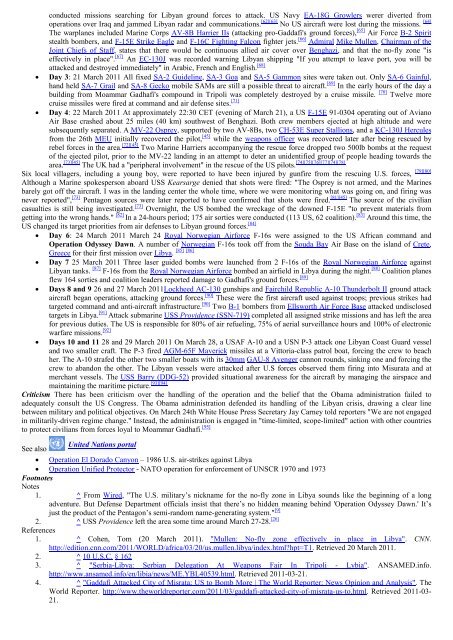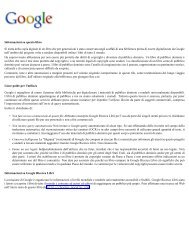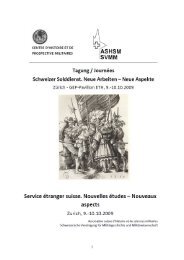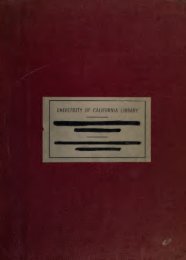Libyan Civil War Libyan Civil War - Libreria Militare Ares
Libyan Civil War Libyan Civil War - Libreria Militare Ares
Libyan Civil War Libyan Civil War - Libreria Militare Ares
You also want an ePaper? Increase the reach of your titles
YUMPU automatically turns print PDFs into web optimized ePapers that Google loves.
conducted missions searching for <strong>Libyan</strong> ground forces to attack. US Navy EA-18G Growlers werer diverted from<br />
operations over Iraq and jammed <strong>Libyan</strong> radar and communications. [62][63] No US aircraft were lost during the missions. [64]<br />
The warplanes included Marine Corps AV-8B Harrier IIs (attacking pro-Gaddafi's ground forces), [65] Air Force B-2 Spirit<br />
stealth bombers, and F-15E Strike Eagle and F-16C Fighting Falcon fighter jets. [66] Admiral Mike Mullen, Chairman of the<br />
Joint Chiefs of Staff, states that there would be continuous allied air cover over Benghazi, and that the no-fly zone "is<br />
effectively in place". [67] An EC-130J was recorded warning <strong>Libyan</strong> shipping "If you attempt to leave port, you will be<br />
attacked and destroyed immediately" in Arabic, French and English. [68]<br />
• Day 3: 21 March 2011 All fixed SA-2 Guideline, SA-3 Goa and SA-5 Gammon sites were taken out. Only SA-6 Gainful,<br />
hand held SA-7 Grail and SA-8 Gecko mobile SAMs are still a possible threat to aircraft. [69] In the early hours of the day a<br />
building from Moammar Gadhafi's compound in Tripoli was completely destroyed by a cruise missile. [70] Twelve more<br />
cruise missiles were fired at command and air defense sites. [71]<br />
• Day 4: 22 March 2011 At approximately 22:30 CET (evening of March 21), a US F-15E 91-0304 operating out of Aviano<br />
Air Base crashed about 25 miles (40 km) southwest of Benghazi. Both crew members ejected at high altitude and were<br />
subsequently separated. A MV-22 Osprey, supported by two AV-8Bs, two CH-53E Super Stallions, and a KC-130J Hercules<br />
from the 26th MEU initially recovered the pilot, [45] while the weapons officer was recovered later after being rescued by<br />
rebel forces in the area. [72][45] Two Marine Harriers accompanying the rescue force dropped two 500lb bombs at the request<br />
of the ejected pilot, prior to the MV-22 landing in an attempt to deter an unidentified group of people heading towards the<br />
area. [73][45] The UK had a "peripheral involvement" in the rescue of the US pilots. [74][75][76][77][74][78]<br />
Six local villagers, including a young boy, were reported to have been injured by gunfire from the rescuing U.S. forces, [79][80]<br />
Although a Marine spokesperson aboard USS Kearsarge denied that shots were fired: "The Osprey is not armed, and the Marines<br />
barely got off the aircraft. I was in the landing center the whole time, where we were monitoring what was going on, and firing was<br />
never reported", [73] Pentagon sources were later reported to have confirmed that shots were fired. [81][45] The source of the civilian<br />
casualties is still being investigated. [73] Overnight, the US bombed the wreckage of the downed F-15E "to prevent materials from<br />
getting into the wrong hands." [82] In a 24-hours period; 175 air sorties were conducted (113 US, 62 coalition). [83] Around this time, the<br />
US changed its target priorities from air defenses to <strong>Libyan</strong> ground forces. [84]<br />
• Day 6: 24 March 2011 March 24 Royal Norwegian Airforce F-16s were assigned to the US African command and<br />
Operation Odyssey Dawn. A number of Norwegian F-16s took off from the Souda Bay Air Base on the island of Crete,<br />
[85] [86]<br />
Greece for their first mission over Libya.<br />
• Day 7 25 March 2011 Three laser guided bombs were launched from 2 F-16s of the Royal Norwegian Airforce against<br />
<strong>Libyan</strong> tanks. [87] F-16s from the Royal Norwegian Airforce bombed an airfield in Libya during the night. [88] Coalition planes<br />
flew 164 sorties and coalition leaders reported damage to Gadhafi's ground forces. [89]<br />
• Days 8 and 9 26 and 27 March 2011Lockheed AC-130 gunships and Fairchild Republic A-10 Thunderbolt II ground attack<br />
aircraft began operations, attacking ground forces. [90] These were the first aircraft used against troops; previous strikes had<br />
targeted command and anti-aircraft infrastructure. [90] Two B-1 bombers from Ellsworth Air Force Base attacked undisclosed<br />
targets in Libya. [91] Attack submarine USS Providence (SSN-719) completed all assigned strike missions and has left the area<br />
for previous duties. The US is responsible for 80% of air refueling, 75% of aerial surveillance hours and 100% of electronic<br />
warfare missions. [92]<br />
• Days 10 and 11 28 and 29 March 2011 On March 28, a USAF A-10 and a USN P-3 attack one <strong>Libyan</strong> Coast Guard vessel<br />
and two smaller craft. The P-3 fired AGM-65F Maverick missiles at a Vittoria-class patrol boat, forcing the crew to beach<br />
her. The A-10 strafed the other two smaller boats with its 30mm GAU-8 Avenger cannon rounds, sinking one and forcing the<br />
crew to abandon the other. The <strong>Libyan</strong> vessels were attacked after U.S forces observed them firing into Misurata and at<br />
merchant vessels. The USS Barry (DDG-52) provided situational awareness for the aircraft by managing the airspace and<br />
maintaining the maritime picture. [93][94]<br />
Criticism There has been criticism over the handling of the operation and the belief that the Obama administration failed to<br />
adequately consult the US Congress. The Obama administration defended its handling of the <strong>Libyan</strong> crisis, drawing a clear line<br />
between military and political objectives. On March 24th White House Press Secretary Jay Carney told reporters "We are not engaged<br />
in militarily-driven regime change." Instead, the administration is engaged in "time-limited, scope-limited" action with other countries<br />
to protect civilians from forces loyal to Moammar Gadhafi. [95]<br />
See also<br />
United Nations portal<br />
• Operation El Dorado Canyon – 1986 U.S. air-strikes against Libya<br />
• Operation Unified Protector - NATO operation for enforcement of UNSCR 1970 and 1973<br />
Footnotes<br />
Notes<br />
1. ^ From Wired, "The U.S. military’s nickname for the no-fly zone in Libya sounds like the beginning of a long<br />
adventure. But Defense Department officials insist that there’s no hidden meaning behind 'Operation Odyssey Dawn.' It’s<br />
just the product of the Pentagon’s semi-random name-generating system." [9]<br />
2. ^ USS Providence left the area some time around March 27-28. [26]<br />
References<br />
1. ^ Cohen, Tom (20 March 2011). "Mullen: No-fly zone effectively in place in Libya". CNN.<br />
http://edition.cnn.com/2011/WORLD/africa/03/20/us.mullen.libya/index.htmlhpt=T1. Retrieved 20 March 2011.<br />
2. ^ 10 U.S.C. § 162<br />
3. ^ "Serbia-Libya: Serbian Delegation At Weapons Fair In Tripoli - Lybia". ANSAMED.info.<br />
http://www.ansamed.info/en/libia/news/ME.YBL40539.html. Retrieved 2011-03-21.<br />
4. ^ "Gaddafi Attacked City of Misrata; US to Bomb More | The World Reporter: News Opinion and Analysis". The<br />
World Reporter. http://www.theworldreporter.com/2011/03/gaddafi-attacked-city-of-misrata-us-to.html. Retrieved 2011-03-<br />
21.
















